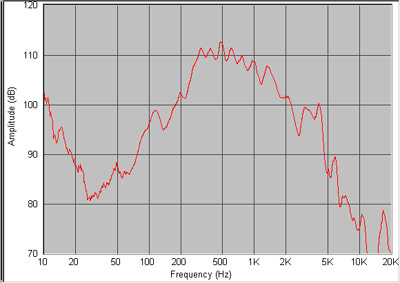
Twin 8" Midrange Horn - Dealing with inexact sciences and cutting strange shapes in wood - |
The catalyst for this was a client requesting additional speakers for his PA system.
He had available 4 home-made trapezoidal cabinets originally fitted with
15" drivers on a short horn, similar to the old JBL 4560 designs, and some
JBL 2426 1" compression drivers. I had previously built for this client a
number of my 12" boxes, and the original plan was to utilise the same 12" horn
design within his old cabinet shells. |
Due to the use of 1" drivers, a higher crossover point was desired, both to increase
the overall power handling capability and to smooth the response across upper
vocal ranges. The old box was crossed at 1.5kHz, and I wanted to use around
2.5kHz in the new design. However, experiments with the 12" design
showed that increasing HF response of the 12" speaker was not going to be practical
- neccesitating a rethink. I had wanted to do some development on midrange horns, and this created the opportunity to do so, and get paid for it as well ! The original concept I had in mind was to fire 2 smaller cone drivers into 45degree reflectors at the throat of a single horn, with the compression driver exiting between the reflectors, but this was not to be. |
I selected the Eminence Beta8 speaker as the basis for experiments. This driver
is rated at 225W RMS, and two of these is actually cheaper than a single Kappa12
anyway. Due to results of some of the measurements on the 12" design,
I decided that experimenting with throat sizes and geometries was in order.
I made up a basic square horn with various throat sections which could be
added on to observe the effects of each. An exponential (actually various
conical sections approximating exponential) horn of around 250Hz cutoff was
used - the mouth area was actually quite a deal smaller than optimum, but this
was not going to significantly effect HF performance. David McBean's Hornresp
program, whilst being quite accurate on low frequency performance, cannot
accurately predict HF performance due to many factors not able to be described
in mathematics. Normal horn wisdom would suggest a smaller throat area for
increased HF output, however I found a number of other factors come into play.
One of these would appear to be cancellations caused by differences in
path length from various points of the speaker cone to the horn throat, and seem
to come into play significantly when the horn throat starts to get smaller than
cone diameter. Shown below are measured results for three different throat
areas (Sd of Beta8 is 214cm^2). |

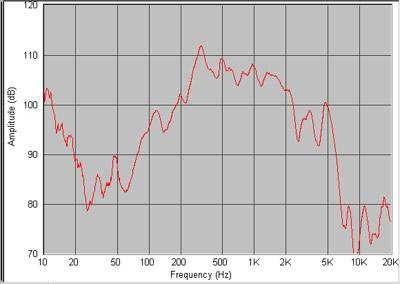
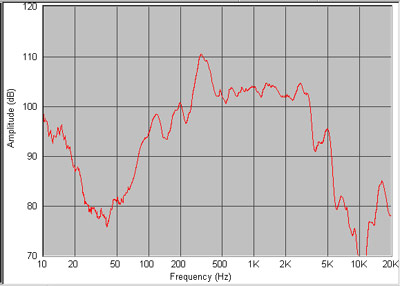
Throat = 49cm^2 |
Throat = 92cm^2 |
Throat = 174cm^2 |
It can be seen that with the smaller throat there are quite a few dips in the response
and the usable HF range is limited, although overall efficiency within the
(narrowed) passband is higher. |
Here the response at 2kHz is improved and the overall level is slightly reduced.
A slight peak ot around 350Hz is also appearing. |
With the larger throat, response has been extended to more than 3kHz, with overall
level slightly lower and 350Hz peak now a concern. Whilst Hornresp predicts
the peak, it doesn't predict this level of HF. |
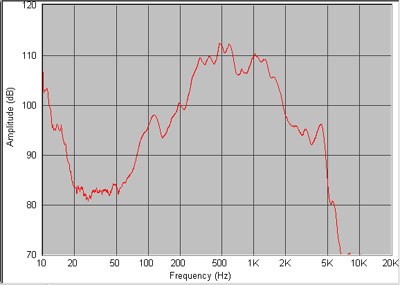
Throat = 36cm^2 with radial phase plug |
In order to reduce path length differences, phase plug experiments were trialed.
As I had tried concentric plugs in the 12" design, I tried an 8-slot radial
plug design here. This significantly reduced effective throat area and
front chamber volume, and resulted in much higher overall SPL, but at the expense
of the HF area I was interested in. |
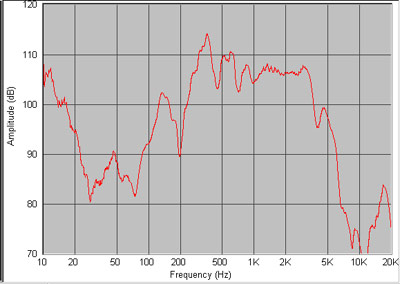
Round throat = 142cm^2 with round phase plug |
I also found that a round throat causes less interference than square, and this is
result of 148mm diameter throat with a 62mm diameter round tapered phase plug
positioned about 5mm in front of the dustcap. This allowed a smaller throat
without covering the cone edge and also effectively reduced front chamber volume
slightly. The overall level was good, however the 350Hz peak is still
there with a bit of ripple as well. The final design was to use a larger
mouth and longer horn, so it was hoped that this area would smooth out a bit. |
The larger than hoped for throat area meant that positioning the speakers either
side of the horn and reflecting or guiding them into the horn was impractical due
to width restrictions in the old boxes. Still wishing to have the 1" compression
driver time-aligned with the 8" speakers, I came up with a design of
positioning the 8" speakers top and bottom of the cabinet with the 1" driver horn
inserted between - therefore everything exits the one horn mouth. It
was certainly complex on paper, and complex to build. |
The phase plugs were cut from 12mm MDF with hole cutter, glued together and lathed
to shape. The central hole was then plugged with dowel. These plugs
were about 62mm diameter and 45mm long. |

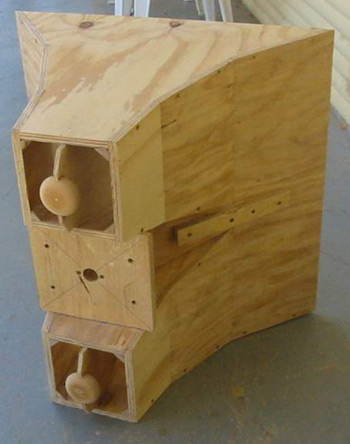
Front and rear view of main flare. The dividers in each throat serve to reduce
HF beaming as well as providing a convenient way of locating the phase plugs.
The 1" compression driver exits via a CD flare between the 8" horns. |

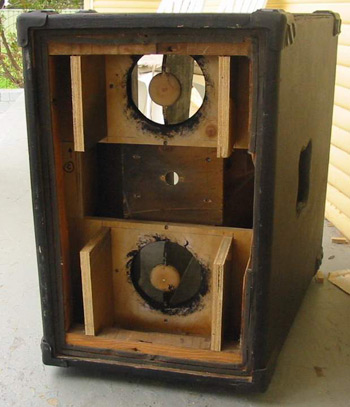
Front and rear view of cabinet prior to fitting drivers. I wish now that I
had talked my client out of using the old box shells - they were hopelesly out
of square and each varied in size, making the job of fitting difficult. |

Components installed. Tests showed the Beta8's liked a small rear chamber,
and these can be seen here - sealing foam was used to seal against the cabinet
rear. |
The Lo pass section of the crossover can be seen on the right side - the Hi pass
section is on the left. As the drivers were time aligned, I used second-order
butterworth filters with reverse phasing to the compression driver |


Completed boxes (shown stacked completely inappropriately for correct operation -
but it LOOKS impressive !!). |
Measured overall response of cabinet. Time alignment of drivers worked well,
with 2.5kHz crossover point invisible in response. Lower level above crossover
point is due to higher impedance of HF section, whilst HF droop is normal
for CD flares. A bit of a hole shows around 700-800Hz region, but in practice
not a great consequence. Enlarging horn to lower low frequency peak
was only partly successful - some of it is reduced by 250Hz active crossover
in client's system, but box still needs an EQ cut around 300-500Hz. |

The cabinets' first gig - two each on two delay towers providing sound to the rear
sections of audience at an open-air Carols-by-Candlelight concert, suplemented
by Cerwin-Vega "Earthquake" subs. These are supplied with electronically time-delayed signal from main PA and separately equalised. As expected, a cut was required between 300-500Hz, but they sounded very smooth and had excellent projection to the rear audience areas. Client very happy !!! (just as well, as he contracts me for FOH engineering at these shows..) |
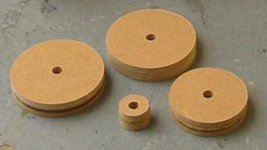
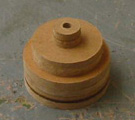

-->> |
-->> |